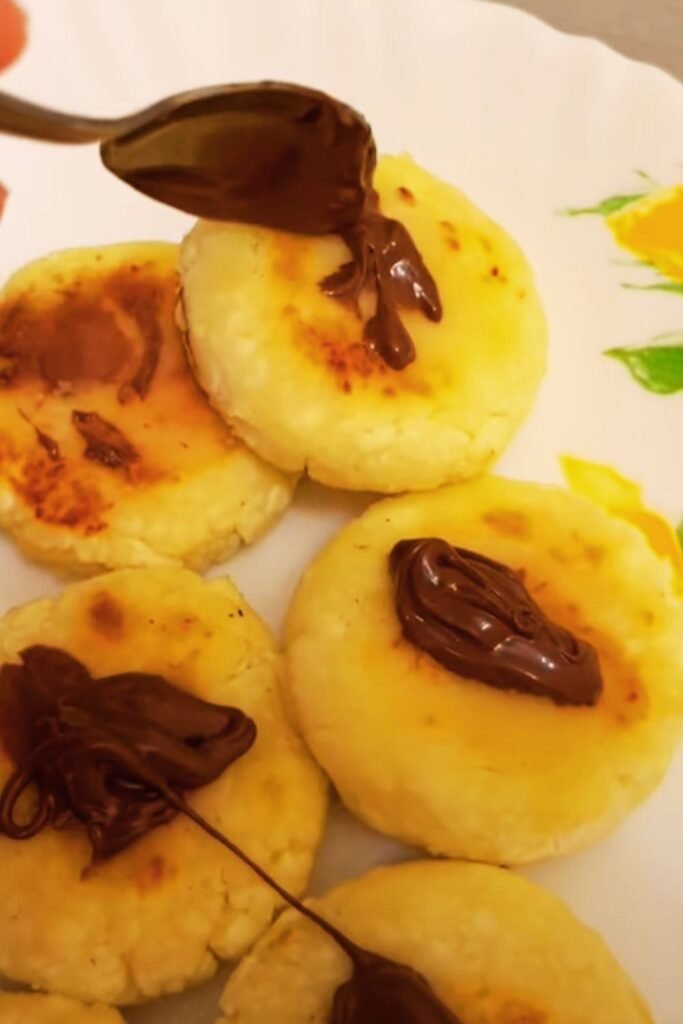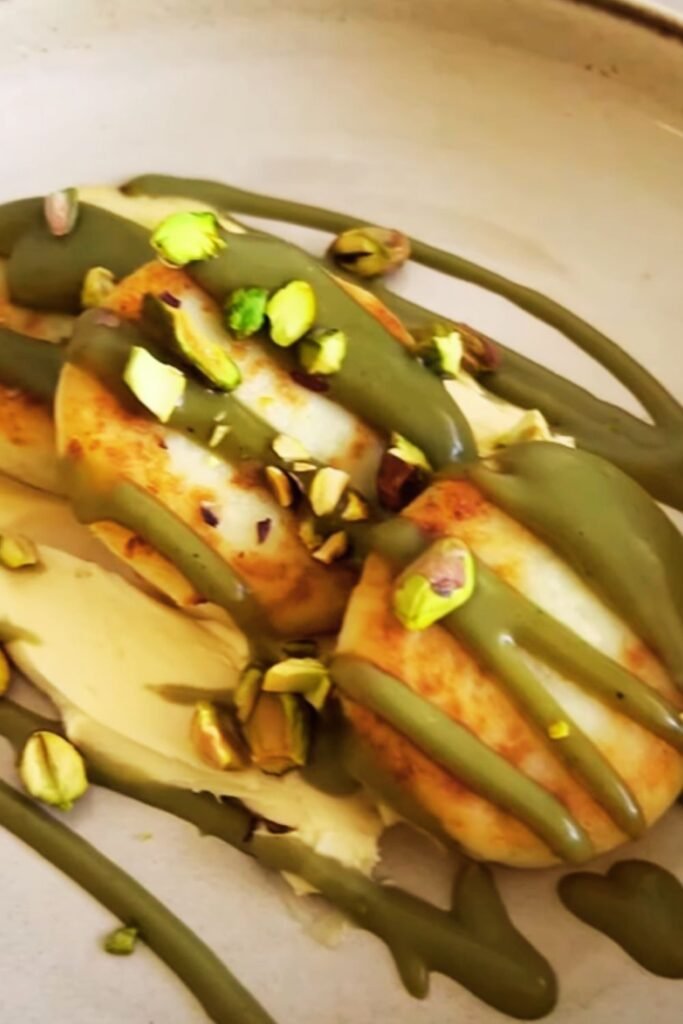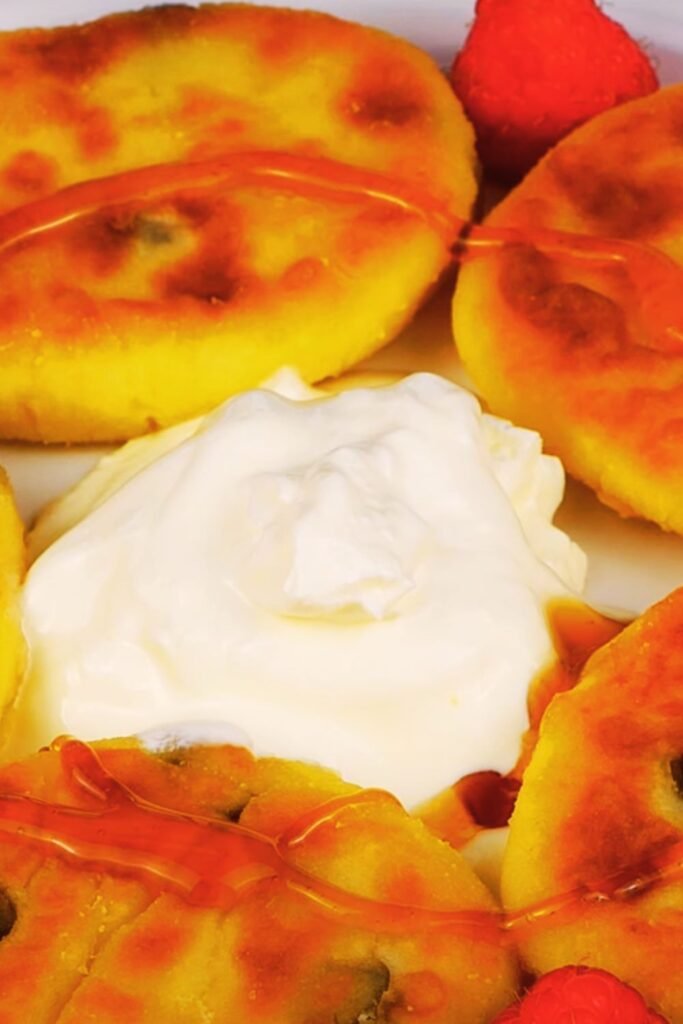A Taste of Russian Comfort Food
I still remember the first time I tasted syrniki. The golden-brown crust giving way to a soft, slightly sweet interior with that distinctive tangy flavor—it was love at first bite. These Russian cottage cheese pancakes have been a breakfast staple across Eastern Europe for generations, and today I’m excited to share everything I know about making the perfect syrniki at home.
Unlike traditional American pancakes, syrniki (pronounced “seer-nee-kee”) are made with farmer’s cheese or cottage cheese as their base ingredient rather than flour. This gives them a unique protein-rich profile and a delightful texture that’s simultaneously fluffy and dense. They’re typically served for breakfast but make for a wonderful dessert as well.
What makes syrniki so special is their versatility. I’ve experimented with countless variations over the years—adding different fruits, spices, and toppings—but the classic recipe remains my favorite. Let me walk you through everything you need to know about making these delicious treats in your own kitchen.
The History and Cultural Significance of Syrniki
Syrniki have deep roots in Slavic cuisine, particularly in Russia, Ukraine, and Belarus. The name comes from the Russian word “syr,” which historically referred to a type of pressed cottage cheese, though nowadays it simply means “cheese” in modern Russian.
These cheese pancakes have been a part of Russian cuisine for centuries, with recipes dating back to at least the 18th century. They were traditionally made in rural households as a way to use up extra farmer’s cheese, which was commonly produced at home. The high protein content made them filling and nutritious—perfect for fueling long days of work.
In Russian culture, syrniki are associated with comfort and home cooking. They’re often prepared for weekend family breakfasts or special occasions. Many Russians have fond memories of their grandmothers making these treats, and the recipe is often passed down through generations with small variations unique to each family.
What I find fascinating about syrniki is how they’ve maintained their cultural significance even as they’ve evolved. Today, you’ll find them on menus in upscale Russian restaurants and casual cafés alike. They represent the enduring nature of comfort food and how simple ingredients can create something truly special.
Essential Ingredients for Authentic Syrniki
The beauty of syrniki lies in their simplicity. While there are numerous variations, the traditional recipe requires just a handful of ingredients:
Farmer’s Cheese (Tvorog)
This is the heart and soul of syrniki. In Russia, a fresh cheese called tvorog is used, which has a consistency similar to pressed cottage cheese. Here in the United States, you can use:
- Farmer’s cheese (ideal)
- Well-drained cottage cheese
- Dry curd cottage cheese
- Quark
- Paneer (in a pinch)
The key is to use a cheese that isn’t too wet—excess moisture is the enemy of good syrniki!
Eggs
Eggs serve as a binding agent, holding everything together. They also add richness and help create that beautiful golden crust when cooked.
Flour
While syrniki are predominantly cheese-based, a small amount of flour is necessary to help bind the mixture and create structure. I typically use all-purpose flour, but you can experiment with alternatives like:
- Rice flour for a gluten-free option
- Semolina for extra texture
- Whole wheat flour for a nuttier flavor
Sugar
Traditional syrniki have just a touch of sweetness. The amount of sugar can be adjusted based on personal preference and what toppings you plan to use.
Vanilla Extract
This is technically optional but adds a wonderful aroma and complements the tangy cheese beautifully.
Salt
Just a pinch enhances all the other flavors.
Additional Add-ins (Optional)
While purists might stick to the classic recipe, I love experimenting with:
- Raisins or dried cranberries
- Lemon or orange zest
- Ground cinnamon or cardamom
- Fresh berries folded into the batter

Equipment You’ll Need
Syrniki don’t require any specialized equipment, which is another reason they’ve remained popular throughout the centuries. Here’s what you’ll need:
- Large mixing bowl
- Fork or potato masher (for mixing the cheese)
- Measuring cups and spoons
- Large non-stick frying pan or cast iron skillet
- Spatula for flipping
- Paper towels for draining excess oil
- Optional: 3-inch round cookie cutter or glass for shaping
Step-by-Step Recipe for Perfect Syrniki
Now, let’s get into the details of making these delicious cheese pancakes. I’ve refined this recipe over years of testing, and it consistently produces beautiful, flavorful syrniki.
Ingredients (makes about 8-10 pancakes):
- 500g (1 lb) farmer’s cheese or well-drained cottage cheese
- 2 large eggs
- 3-4 tablespoons all-purpose flour, plus more for dusting
- 2-3 tablespoons granulated sugar
- 1 teaspoon vanilla extract
- ¼ teaspoon salt
- 2-3 tablespoons vegetable oil or clarified butter for frying
- Optional: ½ cup raisins (soaked in warm water for 10 minutes and drained)
Instructions:
- Prepare the cheese: If using cottage cheese, place it in a fine-mesh strainer and let it drain for at least 30 minutes, pressing gently to remove excess moisture. The drier your cheese, the better your syrniki will turn out.
- Make the batter: In a large bowl, mash the cheese with a fork until smooth (some small lumps are fine). Add the eggs, sugar, vanilla extract, and salt. Mix well until combined.
- Add flour: Gradually add the flour, mixing just until incorporated. You want to use the minimum amount of flour necessary to create a workable dough—too much will make your syrniki dense and tough. The mixture should be soft but firm enough to hold its shape.
- Optional additions: If using raisins or other add-ins, gently fold them into the batter now.
- Chill the dough: For best results, cover the bowl and refrigerate the mixture for 30-60 minutes. This firms up the dough and makes it easier to shape.
- Shape the syrniki: Generously dust your hands and a work surface with flour. Take about 2-3 tablespoons of the mixture and form it into a ball, then flatten it into a thick patty about ½-inch thick and 3 inches in diameter. Repeat with the remaining mixture.
- Heat the pan: In a large non-stick skillet, heat the oil or clarified butter over medium-low heat. The key to perfect syrniki is cooking them slowly to ensure they cook through without burning.
- Cook the pancakes: Carefully place the formed patties into the hot oil, making sure not to overcrowd the pan (I usually cook 3-4 at a time). Cook for 3-4 minutes on each side, or until they develop a beautiful golden-brown crust.
- Drain excess oil: Transfer the cooked syrniki to a plate lined with paper towels to absorb any excess oil.
- Serve immediately: Syrniki are best enjoyed hot!

Common Mistakes and How to Avoid Them
Over my years of making syrniki, I’ve encountered (and made) plenty of mistakes. Here are some common pitfalls and how to avoid them:
Too Wet Batter
Problem: Pancakes spread too much in the pan and don’t hold their shape. Solution: Make sure your cheese is well-drained. If the batter seems too wet even after adding the specified amount of flour, try chilling it longer or adding just a touch more flour.
Too Much Flour
Problem: Syrniki turn out dense and tough rather than tender. Solution: Add flour gradually and stop when the dough is just firm enough to handle. Remember that you’ll also be using flour for dusting when shaping.
Burning on the Outside, Raw on the Inside
Problem: The exterior gets too dark before the interior is fully cooked. Solution: Keep the heat medium-low and be patient. These pancakes need to cook slowly to ensure they’re done all the way through.
Pancakes Fall Apart When Flipping
Problem: The syrniki break apart when you try to turn them. Solution: Make sure they’re well-browned on the first side before attempting to flip. This usually takes 3-4 minutes. Also, use a wide, thin spatula for flipping.
Not Sweet Enough
Problem: The flavor seems bland or too tangy. Solution: Adjust the sugar in the batter to your taste, or simply serve with sweet toppings like honey, jam, or fruit compote.
Nutritional Profile of Syrniki
One of the things I love about syrniki is that they’re not just delicious—they’re also quite nutritious compared to many breakfast options. Here’s a breakdown of what you’re getting in a serving of two syrniki (values are approximate):
| Nutrient | Amount | % Daily Value |
|---|---|---|
| Calories | 220-250 | – |
| Protein | 14-16g | 28-32% |
| Carbohydrates | 20-25g | 7-8% |
| Fat | 10-12g | 15-18% |
| Calcium | 150-200mg | 15-20% |
| Vitamin A | 400-500 IU | 8-10% |
| Vitamin D | 40-50 IU | 10-12% |
| Sodium | 300-350mg | 13-15% |
The high protein content makes syrniki particularly satisfying, helping you stay full longer than many traditional breakfast foods. The calcium content is also significant, thanks to the cheese base.
Traditional and Creative Serving Suggestions
In Russia, syrniki are traditionally served with sour cream (smetana), honey, or jam. However, there are countless delicious ways to enjoy these versatile pancakes:
Traditional Toppings:
- Fresh sour cream
- Honey or maple syrup
- Fruit preserves or jam (cherry and strawberry are classics)
- Fresh berries (strawberries, raspberries, blueberries)
- Powdered sugar for dusting
Modern Variations:
- Greek yogurt with a drizzle of honey
- Fruit compote (apple, berry, or stone fruit work beautifully)
- Nut butters (almond or cashew butter complement the tangy cheese)
- Chocolate sauce for a decadent dessert option
- Savory option: serve with herbs and a dollop of crème fraîche
Complete Breakfast Ideas:
- Serve syrniki alongside fresh fruit and a cup of black tea (very Russian!)
- Pair with crispy bacon for a sweet and savory combination
- Serve with a side of kefir or other fermented dairy drink for a probiotic boost

Storing and Reheating Syrniki
While syrniki are definitely best fresh off the pan, they can be stored and reheated if you want to make them ahead of time or if you have leftovers:
Refrigeration:
- Cool completely and store in an airtight container with layers separated by parchment paper
- Refrigerate for up to 3 days
- Reheat in a dry skillet over medium-low heat for 2-3 minutes per side
Freezing:
- Place shaped, uncooked syrniki on a baking sheet and freeze until solid
- Transfer to a freezer bag or container and store for up to 3 months
- Cook directly from frozen, adding 1-2 minutes to the cooking time per side
Make-Ahead Option:
- Prepare the batter the night before and refrigerate
- Shape and cook in the morning for fresh, hot syrniki with minimal effort
Regional Variations of Syrniki
As with many traditional recipes, syrniki have numerous regional variations across Eastern Europe. Here are some interesting versions you might encounter:
Ukrainian Style
Ukrainian syrniki often incorporate semolina or farina instead of some of the flour, giving them a slightly grainier texture. They’re frequently served with fruit preserves made from local berries.
Belarusian Version
In Belarus, you might find syrniki that include grated apple or pear in the batter for extra moisture and natural sweetness. Some recipes also call for a touch of baking soda to make them fluffier.
Polish Variation
The Polish version, sometimes called serniki, often includes a bit of lemon zest in the batter and might be baked rather than fried for a different texture.
Modern Russian Interpretations
In contemporary Russian cuisine, you’ll find creative versions of syrniki with chocolate chips, candied orange peel, or even savory variations with herbs and garlic to be served as appetizers.
Health Benefits of Syrniki
Besides being delicious, syrniki offer several health benefits that make them a great breakfast option:
- High in protein: The cottage cheese base provides high-quality protein, helping to maintain muscle mass and keep you satiated.
- Good source of calcium: Essential for bone health, the dairy content provides significant calcium.
- Moderate glycemic impact: The protein and fat content help moderate the blood sugar impact of the carbohydrates.
- Probiotics: If using traditionally fermented farmer’s cheese, you may get some probiotic benefits.
- Versatile for dietary needs: The recipe is easily adaptable for different dietary requirements (gluten-free, lower sugar, etc.).
Q&A Section: Common Questions About Syrniki
Q: Can I make syrniki with regular cream cheese? A: While traditional syrniki are made with farmer’s cheese or cottage cheese, you can experiment with cream cheese. However, you’ll need to add more flour since cream cheese has a higher moisture content, and the texture and flavor will be different. For the most authentic results, stick with farmer’s cheese or well-drained cottage cheese.
Q: Are syrniki gluten-free? A: Traditional syrniki contain wheat flour, so they’re not gluten-free. However, you can easily adapt the recipe using rice flour, cornstarch, or gluten-free all-purpose flour with good results. Just be aware that the texture might be slightly different.
Q: Can I make syrniki without eggs? A: Eggs play an important binding role in syrniki, but you can try substituting with 2 tablespoons of ground flaxseed mixed with 6 tablespoons of water (let sit for 5 minutes before using). The texture won’t be exactly the same, but it should still hold together reasonably well.
Q: Why are my syrniki falling apart when cooking? A: This usually happens if the batter is too wet or if you’re trying to flip them too early. Make sure your cheese is well-drained, add enough flour to make a moldable dough, and wait until the first side is well-browned and set before attempting to flip.
Q: Can I bake syrniki instead of frying them? A: Yes! While traditional syrniki are pan-fried, you can bake them at 375°F (190°C) for about 20-25 minutes, flipping halfway through. They won’t have quite the same golden crust, but they’ll still be delicious and will require less oil.
Q: How can I make my syrniki fluffier? A: For fluffier syrniki, you can separate the eggs, beat the whites until stiff peaks form, and then gently fold them into the batter as the last step before cooking. You can also add a pinch of baking powder.
Q: What’s the best cheese substitute if I can’t find farmer’s cheese? A: The best substitute is cottage cheese that has been drained and lightly pressed. Other options include ricotta (drained), Greek yogurt (strained overnight), or quark.
Q: Are syrniki typically a breakfast food or dessert? A: In Russia and Eastern Europe, syrniki are most commonly eaten for breakfast, but they’re versatile enough to be served as a dessert or afternoon snack as well. The toppings often determine how they’re positioned in the meal.
Final Thoughts
Syrniki represent everything I love about traditional cooking—simple ingredients transformed into something truly special through technique and tradition. They connect us to culinary history while still being relevant and delicious today.
What makes these Russian cottage cheese pancakes so wonderful is their adaptability. The basic recipe provides a canvas for countless variations, whether you prefer them classic and simple or loaded with add-ins and creative toppings.
If you’ve never tried making syrniki before, I encourage you to give this recipe a try. Don’t worry if your first batch isn’t perfect—it takes a little practice to get the feel for the right consistency and cooking temperature. But I promise the results are worth it!
There’s something magical about biting into a perfectly cooked syrniki—the contrast between the golden crust and tender interior, the subtle sweetness complemented by tangy cheese, and the comfort of a dish that has sustained generations. I hope you enjoy making and eating them as much as I do!